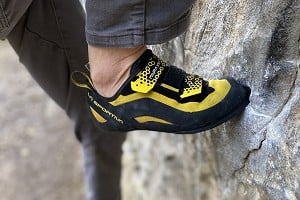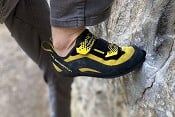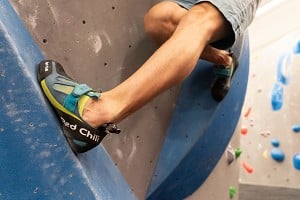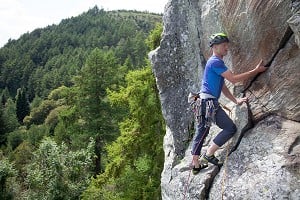
It's interesting that traditionalists such as myself still use the term 'rock shoes', in spite of the fact that a large percentage of climbing shoes sold these days never actually touch rock. It's for this indoor audience that the Beta and Beta Eco were designed. This isn't to say you can't use them outdoors, because clearly you can, but it's more to say that the focus of this shoe is ultimately on the newer climber who's gone indoors for the first time and is looking for something comfortable and cosmetically appealing.
In terms of performance and use, the Beta and Beta Eco are pretty much identical, but differ in the materials used. The Beta Eco, as the name suggests, contains a high percentage of sustainable materials: uppers, midsole, and the central part of the outsole are all constructed using recycled material. Both are available in Men's and Women's versions (which essentially equate to high and low volume).
One of the major attractions of the Beta is its affordability, since £80 is a pretty keen price for a climbing shoe these days. The Beta Eco comes in at a little extra - £90 - but having the option of either/or gives you a choice regarding what materials matter to you.
From this point I'll use 'Beta' as a catch-all term for both, aside from specific differences, where I'll refer to the Beta Eco individually.
The Beta weighs 270g in a size 7.5.
In Use
The Beta has been designed with the indoor climber in mind. This shoe is for someone that has recently started climbing, but - as is the indoor way - is looking at climbing a little harder than, say, someone who'd started their outdoor apprenticeship. The Joker has historically been Boreal's offering in this department, but the advent of indoor bouldering has changed things, with newer users immediately climbing steeper and more technical terrain. Hence what was previously good for beginners is now a little different, depending what they're looking to do.
For a shoe aimed at the indoor market it feels a little stiffer than some, but I suspect this will be a benefit for beginners who have never worn a climbing shoe before, and may gain from the extra support. Its fit is quite relaxed and the knitted uppers are extremely forgiving, making this a gentle introduction to 'rock' shoes, but one where you'll notice a world of difference in performance from a rental shoe.
Whilst all of the above has focussed on the indoors, it's worth noting that you can equally use them outside (obvious though this might sound, we thought we'd say it anyway). We've used them trad climbing and bouldering, and you could certainly sport climb with them too, although this would likely be at the more relaxed end of the spectrum.
Fit
Both the men's and women's models are relatively central in terms of their toe profile and have a very slightly downturned last (although only just - it's barely noticable). The knitted upper gives a nice, comfortable feel next to skin, and is also significantly more breathable than a traditional microfibre upper. Due to the give of this material, it also stretches around your foot and is extremely forgiving on the knuckles of your toe, making for a nice, comfortable first time experience - if indeed this is your first pair of climbing shoes. If not, relish the comfort regardless
When it comes to sizing, we went down a single UK shoe size, which equated to something I could wear out the box without any discomfort. This isn't the shoe you want, or need, to start down-sizing in, because if it's something more technical that you're after then buy something more technical. Throughout use it feels like they give up to half a size, but if anything this only adds to the comfort.
When it comes to the men's and women's fit, the basic difference is the width and volume, with the women's being a little narrower and lower volume.
Rubber
Both the Beta and Beta Eco feature Boreal's Zenith Quattro rubber compound. Compared to Zenith Pro 2, which is their stickiest compound, Quattro is geared a little more towards durability and edging. The end result, on a functional level, is that they'll last longer, but throughout that time offer a little bit less of that grip and stickiness. Understandably there are pros and cons to this. A pro is that indoor climbing tends to be quite hard on your climbing shoes, so a bit of extra durability is going to be welcome. The con, fairly obviously, is that the fact it's not as grippy means it's going to be that little bit slippier. This is definitely noticable, although probably more to expeirenced climbers who've worn other shoes than novices who have purchased their first ever. All I'd say regarding the choice between durability and grip is that when buying, you need to assess your priorities and make a decision accordingly - is long life more important than performance?
The Beta Eco rubber deserves a special mention, because it features Quattro around the toe and heel (i.e. where you most need it) then uses a recycled compound everywhere else - including the rand. Because you don't use these areas as much the grip isn't quite so important, hence we haven't noticed too much of a difference (if any) between the Beta and the Beta Eco as far as rubber is concerned, although we do like the cosmetic appearance - and it's certainly a talking point.
Uppers
The Beta and Beta Eco feature a synthetic knitted upper. This really stretchy, breathable and comfortable material is very forgiving. As a result of this, if you're unused to wearing climbing shoes it'll make for a gentle introduction, almost like wearing a trainer - albeit with the benefits of being an actual climbing shoe. It's also vegan and easily washable*, which - given the odour that climbing shoes tend to emit - is a potentially desirable feature for newcomers who don't want something that smells radioactive (if radioactivity has a scent).
* it's worth noting that if you do wash them, do so on a cold wash - NOT a heated wash (as that'll damage them)
I've already mentioned that the Beta Eco uppers are constructed of a recycled material; however, what I haven't mentioned is how that performs, and the answer is that it's really, really similar. Whilst we haven't done a blind test, my suspicion is that if we had it'd barely have been noticable. As such, the question regading whether or not you want the Eco is one that comes down how much sustainable materials matter to you, rather than on whether it performs any differently.
Given that these are quite a cool looking shoe, designed for an urban audience, it's also worth mentioning that a few different colours are available. It's been interesting to hear differences of opinion regarding this, because whilst down the wall I'd say there's been a split between people who like the look of them and people who say they don't.
Summary
The Beta - and the Beta Eco - are a comfortable and competitively priced shoe that would be ideal either for the beginner just starting out, or as an indoor training shoe for the more experienced climber looking for comfort. Whilst the Quattro rubber might not be quite so sticky, what it lacks in that little bit of grip it makes up for in durability, which could - if you're using them frequently indoors - be of use to make the shoes last longer. If you've been climbing a little longer, or want something more performance oriented, you might find the rubber a little more limiting, although it is - as always - a case of weighing up priorities.
For more info see:






















































Comments
In the section on Rubber:
But just below this is a picture of both shoes with "Zenith" stamped into the soles.
And checking out the product page, they appear to use "Zenith Quattro", so I'm a bit confused by this.
mistake ? Eco more expensive than beta ?
I've been using the Beta women's for a couple of years now. Although I historically have always gone for a more 'performance' shoe, some recent toe issues caused me to seek out something more comfortable. I've worn them for a full range of indoor bouldering up to v7, they work great on slabs, edges, steep ground, heel hooks. The only thing they don't do so well is toe hooking as there is no rubber on top of the toe box.
I have also done lots of bouldering and sport climbing in these. The stiffer sole actually is perfect for supporting the foot on longer routes, and I have got up some relatively hard stuff in them!
I went a full shoe size down from my usual rock shoe size (2 smaller than my trainer size) and they were spot on for use straight out of the box. Can't recommend these enough for any climber who is looking for decent performance without crippling themselves.
I've updated this section to make it clearer, as it was missing a single word which would have made it a lot clearer. In short: Quattro is a more durable, but less sticky compound than Zenith Pro (and it's the Pro bit that I'd forgotten to add).
No, that's correct - the Beta Eco comes in at £90 (vs. the £80 of the Beta).